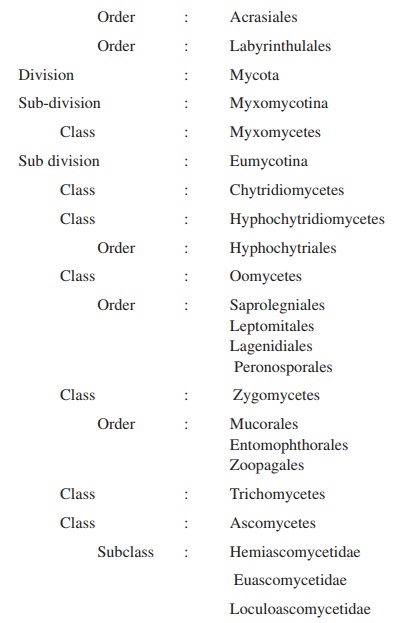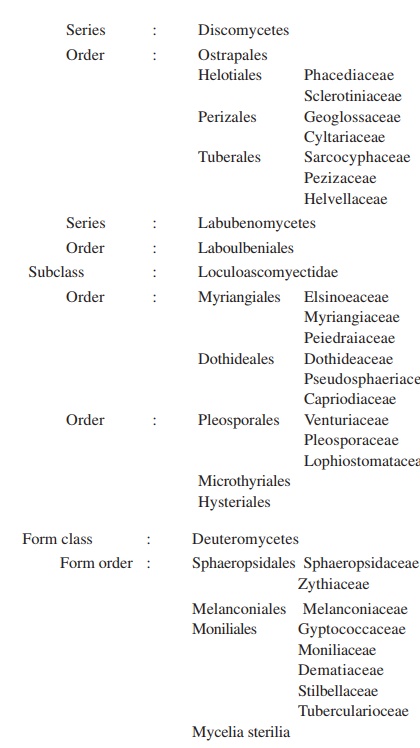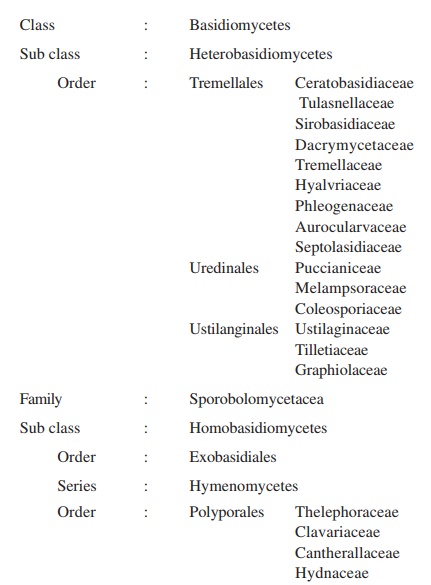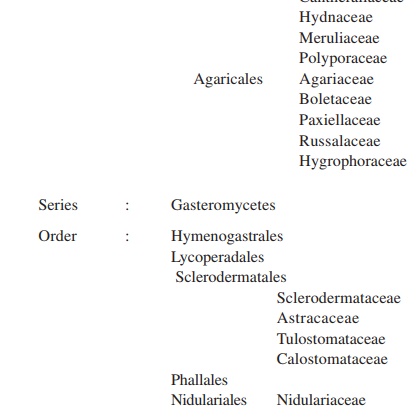Chapter: Microbiology
Taxonomy of Fungi
Taxonomy of Fungi
The study of fungi is known as Mycology (Gr.mykes= mush-room + logos=discourse). The term fungus denote nucleated, spore bearing achlorophyllous organisms with filamentous branched somatic structure surrounded by cell walls containing cellulose or chitin or both. They reproduce sexually and asexually. However, some true fungi are not filamentous and the filaments of some others do not have cell walls. Some algae lost the chlorophyll in the evolutionary process and achlorophyllous but they are not fungi. The cellular slime molds and net slime molds are also studied by mycologists and are not probably fungi.
The fungi include moulds, white rusts, downy mildews, pow-dery mildews, sac fungi, black moulds, blue moulds, cup fungi, morels, truffles, rusts, smuts, mushrooms, toadstools, puff balls, stink horn, coral fungi, earth stars, shelf fungi and bird’s nest fungi. They are both beneficial and harmful to mankind. The yeasts are used in leavening of bread, alcohol production as food and feed, for single cell protein and several products are prepared from yeasts. The mushrooms and truffles are cultivated and eaten. White rusts, rusts, smuts, wilts, leaf spot, blight, blast are plant diseases caused by fungi. The Irish famine was caused by potato blight and the Bengal famine was caused by rice. Most of them occur in soil, decomposing litter, animal dung as saprophytes. There is also a beneficial association between fungi and plants in mycorrhiza (Gr.mykes= mushroom + rizha=root) benefiting both the fungus and plants. The mycorrhizal strands formed from the root runs far away from root absorbs water, phosphorus, micronutrients etc and supplied to the plants. The fungus derives its nutrients from the plants. Thus mycorrhiza are cultivated commercially on host roots and given as biofertilizer for inoculating crop plants. Lichen is an association of fungus and alga knit so close and forming a single thallus. The fungus com-ponent of lichen is called mycobiont and the algal component as phycobiont (Gr mykes = fungus phykos=alga bios = life). The lichen fungi are ascomycetes or basidiobycetes while the lichen algae are blue green algae.
The somatic structure of fungus consists of microscopic strands of filaments branching in all directions and spreading over the substratum. The filament known as hypha (pl.hyphae Gr=hypha=web) is a thin, tubular wall filled with a layer of protoplasm. The protoplasm is continuous without any cross wall (septum; L.septum= hedge, partition) in some fungi (asepatate mycelium or coenocytic) and with cross walls (septate). The protoplasm on each side of a septum is connected by living strands passing through a central pore in the septum.
The composition of the cell wall is not the same in all fungi. In some forms cellulose is the chief constituent and in higher fungi chitin is the chief constituent. Callose a lignin like but carbohydrate substances and other organic materials are also present.
In the hypha a true nucleus with nuclear membrane a nucleo-lus and chromatin strands which organizes to chromosomes dur-ing division are seen. In aseptate hypha nucleus are embedded in the cytoplasm uniformly throughout the mass and the condition is called coenocytic (Gr koinos= common + kytos = a hollow ves-sel). The individual cells of sepate hypha may contain 1,2 or many cells. Uninucleate, binucleate, multinucleate cells (most common) occur on fungi. Vacuoles, oil droplets and other inclu-sions are also present in the mycelium. The mycelium of some higher fungi forms thick strands called rhizomorphs which are re-sistant to adverse conditions and remain dormant until conditions are favourable. In parasitic fungi the mycelium may grow on sur-face or inside the host. It may be intercellular (growing between cells) or intra cellular (penetrating into the cell). The food is ab-sorbed through the host cell wall in the former and in the latter a direct contact with protoplasm is established. Obligate plant patho-gens growing between cells produce haustoria (haustorium L hauster= drinker) that penetrate into the host cells through minute pores punctured into the cell walls or as outgrowth of hyphae and obtain nourishment. Fungi parasitsing on animal tissue are not known to produce haustoria and fungus grown in culture also do not produce haustoria.
The mycelium of most fungi becomes organized into loosely or compactly woven tissues different from ordinary thallus. The term Plectenchyma (Gr.pleko= I weare + enchyma= infusion – woven tissue) denotes all organized fungal tissues. Prosenchyma
(Gr. pros= toward + enchyma= infusion= approaching a tissue) is loosely woven tissue in which hyphae lie more less parallel to one another. Pseudoparenchyma (Gr.psendo= false + parenchyma=a plant tissue) is closely packed more or less isodiametric or oval
cells resembling parenchyma of higher plants. Prosenchyma and the seudoparenchyma compose different types of somatic and reproductive structures like stroma and sclerotium.
Two gametangia of opposite sex come in contact and one or more gamete nuclei move from male to female and fuse. There is no fusion of gametangia. The male nuclei enter the female gametangium through a pore developed by the dissolution of gametangial walls at the point of contact. In some fungi fertilization tube is formed for the passage. The antheridium disintegrates after the passage of nucleus but the oogonium develops.
Gametangial copulation occurs due to fusion of the contents of the two contacting gametangia. In holocarpic forms where en-tire thallus acts as gametangium passage of one gametangial con-tent (male) to the other (female) through a pore developed at the contact point. In others direct fusion of two gametongial cells occur.
Spermatia, uninucleate, spore like male structure, produced by certain fungi are carried by insects, wind or water to the female gametangia or to the receptive or somatic hypha. The contents of spermatia pass into the receptive structure, female organ, through a pore developing at the contact point.
In many of the higher fungi no sex organs are produced and the somatic cells functions like sex organs as they come in contact and fuse.
The nuclear cycle in fungi generally involve haploid, diploid cycle. The diploid nuclei resulting from karyogamy become haploid after meiosis. Heterokaryosis is a phenomenon wherein nuclei of the genetically similar or different fungi exist in the same
cell of hypha. The cells may not contain the same number or same kind of nuclei or the same proportion of each kind in a mixture of nuclei. Each nucleus is independent of all nuclei in the heterokarytic condition.
The fungi may be classified on the basis of sex as (1) hermaphroditic (2) dioecious and (3) sexually undiffentiated thallus producing morphologically indistinguishable male or female. On the basis of sexual compatibility fungi are grouped as (1) Homothallic (2) heterothallic and (3) secondary homothallic fungi. In homothallism every thallus is self fertile and can reproduce without another thallus. Hermophrodite thallus are of this type. No dioecious fungi can be homothallic. In heterothallic fungi every thallus is self sterile and requires another compatible thallus of different mating type. Heterothallic fungi may be either bipolar heterothallic or tetrapolar heterothallic. Two mating types differing in their genetic make-up for the compatibility factor occur in the biopolar mating type. Each of the nucleus of one mating type carries the gene A and each of the nucleus of other mating type carries gene a. Those thalli carrying opposite genes of the pair Aa are compatible. Four mating types occur in heterothallism wherein the compatibility is determined by two pair of factors Aa and Bb located in different chromosomes. Those thallai carrying nuclei of opposite genes of both the Mendelian pair Aa and Bb are compatible forming the zygote of AaBb genotype.
Secondary homothallism occur in fungi during the spore formation of bipolar heterothallic fungi. The two nuclei of opposite mating type are present in each spore which upon germination gives a thallus containing both A and a nuclei and then behaves as homothallic.
Some fungi derive the benefits of sexuality through parasexuality without true sexual cycle (Gr.para=beside). In parasexual method plasmogamy, karyogamy and haploidization occur but not at specified points of life cycle. In the Deuteromycetes group parasexuality occurs and no sexual reproduction. Some fungi reproduce
sexually and parasexually.
In mycology certain organisms of uncertain affinity like the cellular slime molds and net slime molds are also studied. The cellular slime molds are grouped under order Acrasiales. The cells are naked haploid amoeba feeding on bacteria. The cells are not
flagellated but cells aggregate together forming pseudoplasmodium. The cells never fuse but remain individually but cooperate. Sorocarps (Gr.soro=heap+karpos=fruit) are fruiting bodies. Cultivated soils are richer in cellular slime molds.
The net slime molds are grouped in the order L.abyrinthulales. These are aquatic, mostly marine or terrestrial organisms with naked uninucleate spindle or oval shaped cells. These cells become interconnected by slime filaments forming a net along which they glide. The majority of species are marine associated saprobicaly or parasitically with marine algae Ulva or cause a disease in higher plants Zostera marina.
The lower fungi includes the true slime molds (Class: Myxomycetes), posteriosly uniflagellate fungi (Class: Chytridiomycetes) anteriorly uniflagellate fungi (Class: Hyphochytridiomycetes), including water molds, white rusts and downy mildews forming
oospores (Class: Oomycetes)endoparasitic slime molds (Class: lasmodiophoromycetes) and bread molds, fly fungi and animal traps (Class: Zygomycetes). The higher fungi are the sac fungi (Class: Ascomycetes) including yeasts, leaf curl, black molds, blue molds, perithecial fungi, cup fungi, morels, truffles, parasitic fungi of insects and arachnids, the imperfect fungi (Form Class: Deuteromycetes), smuts, rusts, jelly fungi, mushrooms, puf and stinkhorns (Class: Basidiomycetes). Fungi form new in-dividuals by sexual and asexual reproduction. Asexual (somatic or vegetative) reproduction does not involve union of nuclei or sex cells or sex organs whereas sexual reproduction is by union of two nuclei. The fungus is known as holocarpic when the entire thallus is converted into one or more reproductive structures and both somatic and reproductive phases do not occur together on the same individual (Gr:holos= whole + karpos=fruit). In most of the fungi separate reproductive organs arise from a portion of thal-lus and the remainder remains as somatic structure continuing its activities. Such fungi are known as eucarpic (Gr.eu=good+karpos=fruit). The holocarpic forms are primitive than eucarpic fungi. Stomata (pl.stromata Gr.stroma= mattress ) is a compact like a mattress on / in which fungal fructifications are formed. Scletotia (pl.sclerotia Gr.skelros= hard) is hard resting body resisting unfavourable conditions that remains dormant until favourable conditions returns.
Asexual reproduction results in the production of numerous individuals and important in propagation of species, repeated sev-eral times whereas the sexual stage is produced once in a season or year. Asexual reproduction occurs in several ways like (i) fis-sion as in fission yeasts (ii) budding as in budding yeasts (iii) frag-mentation of somatic structure each of which giving rise to a new individual (4) spore formation, each spore germinating to form new individuals.
In fragmentation the hypha breaks up into their component cells called oidia (Oidium, Gr.oidion=small egg) or arthrospores (Gr.arthorn=joint+sporos=seed, spore) which function like spores.
In certain cases the cells are enveloped with a thick wall even before they separate and are called chlamydospores (Gr.chlamys=mantle+spores=seed, spores). Fission is division of a cell into two daughter cells by formation of a cross wall in some yeasts. Bud is a small outgrowth from a parent cell and when it is formed the nucleus divides and the daughter nucleus move into the bud. The bud grows in size and breaks and forms a new individual. Budding takes place in majority of yeasts and many other fungi under certain conditions. Production of spores is the common method in many fungi. Spores vary in colour from colourless (hyaline Gr.hyaline= made of glass i.e., colourless) through green, yellow orange, red, brown to black and also vary in size and shape. Some fungi produce only one type of spore whereas others produce more types. Asexual spores are called sporangiospores when they are borne in sporangia a sac like struc-ture (Gr.sporos=seed,spore+angeion=vessel) or called conidia when borne on the tips of hypha (Gr konis=dust, idion, dimin suf-fix.) The whole content of sporangium may develop into one or more spores. Sporangiospores are of two types zoospores and aplanospores. Zoospores are motile with one or two flagella while aplanospores are non motile. The flagellum may be of whiplash or tinsel type.
Sexual reproduction, the union of two compatible nuclei, consists of three phases viz., plasmogamy, karyogamy and meio-sis. Plasmogamy (Gr.plasma= a molded object i.e, a being + gamos= marriage, union) union of two protoplasts occur bringing tow hap-loid nuclei together in one cell. In karyogamy (Gr.karyon = nut, nucleus + gamos = marriage) fusion of the two nuclei occur into one diploid zygote nuclei. This second phase follows immedi-ately plasmagamy on lower fungi and in higher fungi it is delayed resulting in a dikaryotic (dikaryon di=two + Gr.karyon=nut). the dikaryon = condition may be perpetuated from cell to cell by the division of the associated nuclei and by the separation of the two daughter cells. Meiosis occur sooner or later after the fusion of two nuclei restoring the haploid condition in the four nuclei formed. In order to effect sexual reproduction some fungal species produce male and female sex organs (gametangia) in each thallus (hermophroditic species-bisexual (Gr.Hermes = the messenger of the Gods,the symbol of the male sex + Aphrodite = the goddess of love, the symbol of female sex). In other species some thalli produce only male sex organs and others produce only female sex organs (dioecious).
Gametangia, the sex organs, form cells called gametes ormay certain one or more nuclei. the morphologically similar butphysiologically different male and female gametangia and gametesare called isogametangia and isogametes. If they can be differentiatedthen they are called as heterogametangia and heterogametes.In heterogametangium the male is designated as antheridiumand the female is called as oogonium.
The most common method of plasmogamy are (1)Planogametic copulation (2) gametangial contact (3) gametangialcopulation (4) spermatization (5) somatogamy.
In Planogametic copulation two naked gametes, one or bothmotile fuse together. The gametes may be isogamous or anisogamous.In some cases the female is non motile and male is motile.The male gamete enters the oogonium and fertilizes the egg.
The class Myxomycetes contain the true slime molds. Theacellular creeping somatic structure of slime molds are animal likein structure and physiology but the reproductive structures are plantlike producing spores. They live in moist shady places dead leaves,on decaying logs or other organic matter. They occur in grasseslawns and develop in bark of trees. They feed on bacteria, protozoaand other minute organisms.
The class chytridiomycetes are coenocytic fungi producingmotile cells (zoospores) with a single posterior whiplash flagellum.They occur in aquatic habitat and some parasitize algae.
The class Hyphochytridiomycetes consist of aquatic fungi producing anteriorly unflagellate motile cells with tinsel flagellum. Rhicidiomyces apophysatus is parasite on the oogonia of water molds.
The class Oomycetes consists of water molds, white rusts and downy mildews. These fungi produce asexually by means of biflagellate zoospores bearing one forward tinsel flagellum and one backward whiplash flagellum. Albugo, Peronospora, Plasmopra, Pythium and Phytophthora are parasitic on plants.
The class Plasmodiophoromycetes consist of fungi which are obligate endoparasites of vascular plants, algae and causing hypertrophy.Plasmodiophora brassicae cause club root of cabbage. Spongospora subterranea causes powdery scab of potatoes.
The class Zygomycetes are characterized by zygospore formation in sexual reproduction and non motile sporangiospores or conidia in asexual reproduction. The majority of them are saprophytice living on dung, decaying plant or animal matter. The
common bread mold Rhizopus stolonifer is used for the industrial manufacture of fumaric acid and cortisone. A few of them are weak parasites of fruits, soft rot of sweet potatoes. Entomopathogenic fungi like fly fungus Entomophthora muscae are found in dead housefly. The zoopagaceus fungi parasitize amoebae, rhizopods and nematodes.
The class Trichomycetes consists of fungi associated with anthropods. They are widely distributed and not parasitic but commensals.
The class Ascomycetes and the class Basidiomycetes are known as higher fungi and produce ascospores and basidiospores respectively. The yeasts, black molds, green molds, the powdery mildews, the cup fungi, the morels and the truffles are ascomycetous fungi. Many are parasitic on plants, some are saprophytic living in soil, decaying logs and leaves. The yeast Saccharomyces cerevisiae are used in bread leavening, production of beverages like beer, wine, alcohol production, in single cell protein production and enzymes. Chaetomium is cellulolysic in soil aiding decomposition. The ergot fungus Claviceps purpurea cause plant disease in rye, cumbu, etc., the sclerotia of which are deadly to animals when consumed. The Penicillium that produces Pencillin antibiotic and the omnipresent Aspergilus spp., belong to this class.
Ascus, the sac like structure containing definite number of ascopores are produced by the fungi in sexual reproduction. Eight are usually formed in an ascus but this may vary from 1 to 1000 according to species. The asexual reproduction in ascomycetes is by fission, fragementation, blastospores (budding) anthrospores,
chlamydospore or conidia. The fruiting bodies formed in ascomycetes are (1) pycnidium (2) Acervulus and these contain conidiophores bearing conidia. The ascomycetes have two different reproductive phases, the ascus or sexual stage (ascigerous or perfect
stage) and the conidial or asexual stage (imperfect stage). Ascomycetes are classified based on the characteristics of perfect stage. But the conidial stages of number of ascomycetes have not been found. Further there are large number of fungi known only
by conidial stages and are designated as imperfect fungi(form class Deuteromycetes).
These are ascomycetes which have lost their ascus stage in the evolutionary development. The Ascomycetes are further divided into three subclasses (1) Hemiascomycetetidae (2) Euascomycetidae and (3) Loculoascomycetidae. The Hemiascomycitidade includes yeasts (Order: Endomycetales) and leaf curl fungi (Order:
Taphrinales). The Eusascomycetidae is divided into series (i) Plectomycetes (ii) Pyrenomycetes and (iii) Discomycetes and (iv) Laboul-bemycetes. The Plectomycetes include black molds (Asperigillus) green molds and blue molds (Penicillium). The
series Pyrenomycetes contain those fungi that produce ascus in globose or flask shaped perithecium. The Discomycetes include cup fungi, earth tongues, the morels and the truffles that are recognized by their cup or disc shaped fruiting bodies produced on the ground. The brown rot of peach and other stone fruits is caused by Monilinia fructicola of this group. The truffles (genus Tuber) are commercially exploited as food in European countries. The series Laboullbeniomycetes include parasites of insects and arachnids. Herpomyces parasitize cockroaches. The series Loculoascomycetidae are ascostromatic fungi that produce asci in stromatic locules. These fungi are parasitic to plants and insects. Elsinoe faucetti causes citrus scab andE.ampelina cause anthracnose of grapes. Myriangium spp. are parasitic on insects. Mycospherella musicola causes sigatoka disease of banana.Venturia indqualis attacks apple.
The form class Deuteromycetes includes those imperfect fungi that lack a sexual phase or perfect stage. Most of them are saprophytic but many cause diseases of plants, animals and human. It is presumed that the imperfect fungi represent conidial
stages of ascomycetes whose perfect stage (ascigerous stage) are rarely formed or not been found or have been lost by these organisms in their evolution. Whenever sexual stages are found in a few species then they are classified under ascomycetes. In certain
cases the perfect stage have been found to be similar to those of Basidiomycetes. Hence fungi imperfercti are considered as conidial stages of ascomycetes or rarely as basidiomycetes whose sexual stages have not been found or do not exist. In this group parasexual cycle brings the advantages of sexuality.
Blastospores, conidiospores, chlamydospores, phialospores, anthrospores, porospores (conidia produced from the pores of conidiosphores) are common in Deuteromycetes. The most important species that cause plant diseases are Septoria thespsia (leaf spot of Thespesia), Colletotrichum capsci(fruit rot of chillies) C.lindemuthianum ( bean anthracnose), Helminthosporium oryzae (sesame leaf spots of rice), Cercospora personata, C. arachidicola (tikka leaf spot of groundnut), Alternaria (leaf spot), Rhizoctonia solani (root rot of groundnut), Sclerotium rolfsii (stem rot of rice)
andFusarium oxysporum f. cubense wilt of banana). Cercospora apii was isolated form skin lessons of human.
The class Basidiomycetes includes mushrooms, toad stools, puff balls, bracket fungi, the smuts, rusts and jelly fungi and stink horns. These produce their spores (basidiospores) usually on the outside of the spore producing body called basidium and hence the name Basidiomycetes. Basidiospores are uninucleate and hap-loid.
The subclass Heterobasidiomycetidae includes jelly fungi, rusts and smuts. Jelly fungi are so called due to the jelly like fruit-ing bodies (some are waxy and cartilaginous). Some species of Tremella is used as food by Chinese people Septobasidium parasitizesous scale insects. The wheat rustPuccinia graminis,Cumbu rust Puccinia penniseti, the bean rust Uromycesappendiculatus are devastating diseases. Uredia producing ure-dospores and Telia producing teleutospores are common in rusts. Puccinia graminis, the creal rust has an alternate host barberry in which aecial stage occurs but uredial and telial stages occur in wheat.
The smuts are parasite and produce black dusty spore massresembling soot or smut. Tilletia caries (bunt of wheat) Uromycismaydis (corn smut)Ustilago scitamina (sugarcane smut),Sphacelotheca sorghi (sorghum smut) are very common diseases.
The subclass Homobasidiomycetidae includes mushroom,shelf fungi, coral fungi, puff balls, earthstones, stink horns andbird’s nest fungi.Exobasidium attacks flowering plants causesabnormal swelleing of host tissues. Poria, Fomes, Polyporus andGanoderma are wood rotting fungi.Agaricus and Pleurotus areedible mushroom. Amanita is poisonous. A.muscaria , fly mushroomis used as an insecticide. The species of GlomusandAcaulospora are mycorrhizal fungui exploited as biofertilizer.
Outline classification of Fungi by Alexopoulous
The fungi are classified with plants under the kingdom peantae and division mycota.





Related Topics